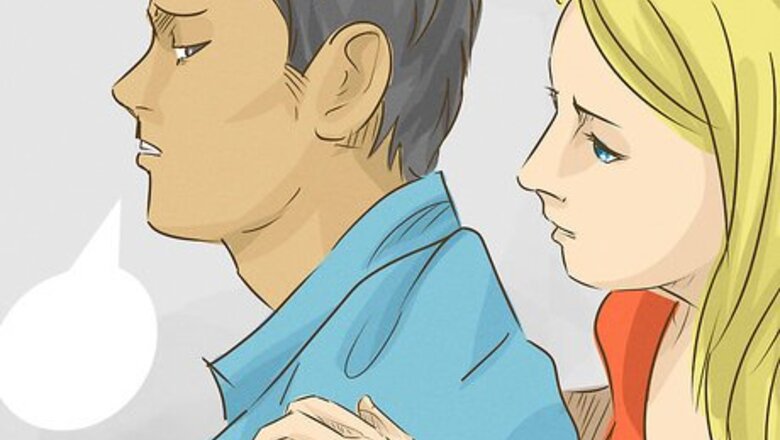
views
Expressing Emotions Openly

Become a safe haven. People need to feel comfortable sharing their thoughts and feelings. Show the man that you can be trusted and counted on when he’s dealing with emotions. Invite the man to share his emotions with you. When he does share, don’t judge or criticise what he says. If discussions escalate, take a timeout before either of you say something that might be regrettable. Validate his feelings by saying, “I can see you feel sad about that” or, “It sounds like that made you feel upset.”

Help him identify his feelings. Tears can indicate a person’s emotions, and without this cue, he might not know how to label how he feels or communicate those feelings with others. Help him identify feelings or show your understanding. Instead of assuming you know how he feels, ask questions. For example, ask, “Does that make you feel sad?” or, “I know I would feel angry, how do you feel?”

Confront feelings of emotional perfectionism. It is normal for people to hide their emotions and put up a façade to hide their true feelings, and this is especially true for men. One of the biggest struggles for men in any setting especially in relationships is being openly vulnerable to the other person. In many situations, men are taught to be strong, to take care of other people, and if they were to express vulnerability it is a sign of weakness. Some people feel like being in complete control of their thoughts and emotions makes them strong and resilient. Tears and crying may be perceived as being out of control or weak. The man may fear feeling rejected or made fun of by others if seen crying in public. Talk to the person about what it means to have emotions and how he relates to them. Does he have to feel in control of himself at all times, and does that affect his ability to cry? Be open and honest with him, and express to him that withholding emotions could be a sign of ambivalence, being unavailable, or being afraid to fully commit to the relationship. Let him know that it is attractive when he is able to openly express his emotions without fear.

Practice sharing your feelings together. Instead of putting pressure on the man to share his feelings, make it collaborative. Take turns sharing something personal or slightly vulnerable. Getting the man comfortable talking about his feelings can help him feel freer to express them. Assisting him with understanding that allowing himself to feel his emotions will help him to develop deeper more meaningful connections may help. For example, you can buy a deck of question cards and ask each other one question each night. By increasing this trust and bonding with each other, he may eventually feel more empowered and confident with expressing his feelings towards other people. Some men have noted that by accepting and allowing themselves to fully express their emotions, they open up a whole new side of themselves that feels more meaningful, and enables them to create deeper long-term bonds with other male friends

Connect with sentimental memories. Men don’t have to cry to express only sadness and grief. Ask him what he connects to that brings about the feeling of tears. Perhaps it’s the memory of his child being born, a beautiful sunset, or a dramatic victory. Help him enter into the memory and the feeling of something that may make him tear up or cry. Even if he doesn’t cry, he can at least experience memories that make him feel sentimental and in touch with his emotions. This can be a good starting point.
Bringing Up Crying

Ask him about it. Talk about why he struggles to share his emotions and what might stop him from crying. Does he struggle to connect with emotions that lead to crying? Does he tend to shove emotions down and not deal with them? Does he want to cry or is he more comfortable staying away from tears? Get an idea about what stops him from crying to better understand him. Ask him if he’s cried in the past and what that was like. Was he ashamed or made fun of by others? Was he alone or in public? Did he tell himself he would never cry again? To start a conversation, say, “I’m really curious as to why it’s difficult for you to cry. Can we talk about it? Is there something I can do to help?”

Talk about the benefits of crying. Crying helps release emotions that are otherwise pushed down. These repressed emotions can build up over time and develop into clinical symptoms such as high blood pressure. Crying can also be linked with higher self-esteem. Not all people are comfortable crying in front of others. If the person is hesitant to cry in front of you or other people, say that crying can help even if they do so privately.

Cry in front of him. Seeing someone else cry can show that tears are okay and come from valid emotions. The man might be grateful that you feel comfortable enough to cry in front of him or he might realize it’s not as big of a deal to cry as he had thought. Sometimes, witnessing tears can be helpful to normalize tears.
Getting Outside Support

Refer him to an individual therapist. Sometimes, the most helpful thing you can do is to suggest outside help. Encourage the man to see a therapist. Emotions have many layers, and sometimes we need to peel back those layers like an onion to get to the core or root cause of why it is difficult to show certain emotions. He may be struggling with a past trauma that makes crying or tears feel bad or judged, or may have problems expressing his feelings in general. A therapist can help him work through his emotions and give him coping strategies to help him deal with stress and problems more effectively. Especially if he’s had a difficult experience in childhood or endured a tragedy, it can be difficult to reconnect with crying when it’s associated with such pain. A therapist can help him explore his emotions and cry in a way that makes him feel safe. Individual therapy allows for a safe confidential space for him to peel back any emotional layers he may have, study them, and see how they function. Individual therapy is a safe place for him to freely experiment with his emotions that he didn’t otherwise know how to express without inhibition before.

Try somatic psychotherapy. Based in the mind-body connection, somatic therapy can help release traumas in the body that affect physical and emotional health. Sessions may include becoming aware of sensations in the body, movement, and breathing exercises. For example, some people describe a knot in their stomach, and working with these feelings can help release the person to feel free to cry.

Ask him to attend group therapy. A group can be a great place to gain support and put things in perspective. He can learn skills and practice with others to allow him to be more emotionally vulnerable. He might want to join a group that is exclusively for men who struggle to express emotions. Group therapy is led by a therapist and typically consists of 5-15 people who are struggling with a similar issue. Some people go to individual and group therapy while others just attend group therapy.




















Comments
0 comment